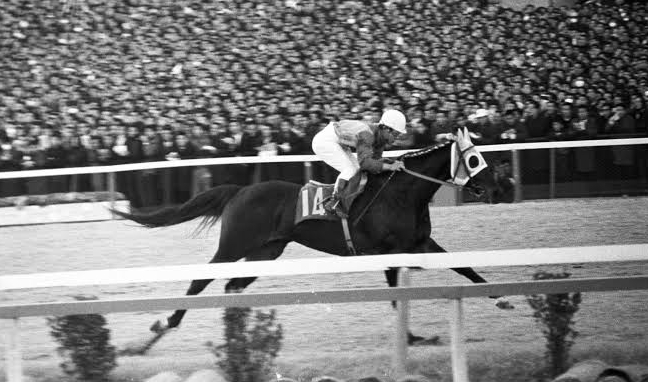1. Who Was Speed Symboli?
Born in 1963 in Hokkaido, Japan, Speed Symboli was a slender but spirited Thoroughbred bred by Symboli Farm. With long legs and a lean build, he didn’t appear to be a standout at first glance. However, he possessed unmatched stamina and resilience, traits that would define his legendary career. Sired by Irish stallion Royal Challenger and out of the British mare Sweet Inn, his European lineage hinted at the international road ahead.
His main jockey was Yuji Nohira, a skilled horseman whose partnership with Speed Symboli led to unforgettable moments in Japanese racing history.
Speed Symboli – Five-Generation Pedigree
| Generation | Sire Line | Dam Line |
|---|---|---|
| 1st | Royal Challenger | Sweet Inn |
| 2nd | Royal Charger | Rising Light |
| 3rd | Nearco × Sun Princess | Gainsborough × Selene |
| 4th | Pharos × Nogara | Hyperion × Bread Card |
| 5th | Solario × Mumtaz Begum | Manna × Book Debt |
Inbreeding: Gainsborough 4x5x4x5, Hyperion 3×4 (dam side), Phalaris 5×5
2. Domestic Dominance and the Rise of a Veteran Hero
Speed Symboli claimed his first major victory in the Keisei Hai and went on to win key races such as the Tenno Sho (Spring), Meguro Kinen, Takarazuka Kinen, and twice the Arima Kinen. In 1967 and 1970, he was crowned Japan’s Horse of the Year. Remarkably, his second Arima Kinen win came at the age of eight—an age considered past prime—securing his status as Japan’s “veteran hero.”
Speed Symboli – Major Race Results
| Date | Race Name | Track | Distance | Finish | Jockey |
|---|---|---|---|---|---|
| 1967-04-29 | Tenno Sho (Spring) | Kyoto | 3200m (Turf) | 1st | Yuji Nohira |
| 1967-06-25 | Nihon Keizai Sho | Nakayama | 2500m (Turf) | 1st | Yuji Nohira |
| 1969-07-26 | King George VI & Queen Elizabeth Stakes | Ascot (UK) | 2400m (Turf) | 5th | Yuji Nohira |
| 1969-10-05 | Prix de l’Arc de Triomphe | Longchamp (FR) | 2400m (Turf) | Unplaced | Yuji Nohira |
| 1969-12-21 | Arima Kinen | Nakayama | 2500m (Turf) | 1st | Yuji Nohira |
| 1970-12-20 | Arima Kinen | Nakayama | 2500m (Turf) | 1st | Yuji Nohira |
3. Overseas Challenges and the Harsh Reality
In 1967, Speed Symboli took on the Washington D.C. International Stakes in the United States. Though he was the least favored in the betting, he finished an impressive 5th. But it was in 1969 that his most ambitious campaign began—a long European tour.
He participated in the King George VI and Queen Elizabeth Stakes at Ascot, where he briefly took the lead but ultimately finished 5th. This was followed by a 10th place finish at the Grand Prix de Deauville in France, and a subpar result in the Prix de l’Arc de Triomphe (11th or worse). These races exposed the wide gap between Japanese and European horse racing at the time.
Still, in an era when international travel was difficult and expensive, owner Tomohiro Wada’s bold decision to send Speed Symboli abroad was groundbreaking.
▶️ Feature on Yushun Web
▶️ 1969 Arima Kinen Race (JRA Official YouTube)
4. The Epic Arima Kinen Battles
In the 1969 Arima Kinen, Speed Symboli faced off against the rising star Akane Tenryu in a heart-stopping duel. He narrowly won by a nose after four years of trying. A year later, he returned as an eight-year-old to claim victory again, defeating both Akane Tenryu and Date Tenryu in a fierce three-way battle. These back-to-back wins made him the first horse to win the Arima Kinen twice, setting an enduring legacy.
5. Retirement and Hall of Fame Induction
Though Speed Symboli did not succeed as a stallion, he left an indelible mark through his descendants. He became the broodmare sire of notable horses like Symboli Rudolf. In 1990, he was inducted into the Japan Racing Association Hall of Fame, a fitting tribute to his achievements.
6. The Bigger Message: What Speed Symboli Taught Us
His journey wasn’t just about winning or losing—it was about challenging the world. Speed Symboli’s struggles overseas underscored the structural and environmental differences between Japanese and Western tracks, igniting a long-term evolution in Japanese horse racing.
That spirit of international ambition laid the groundwork for future champions like El Condor Pasa, Deep Impact, Orfevre, and Equinox. Speed Symboli ran so that others could soar.
7. In Closing: The Symbol of Challenge
Speed Symboli wasn’t just a racehorse. He was a symbol of perseverance and global ambition. His long career, highlighted by back-to-back Arima Kinen wins and fearless international ventures, left a profound legacy in Japan’s racing history.
For more legendary racehorses, visit our Favorite Horses archive.







コメント